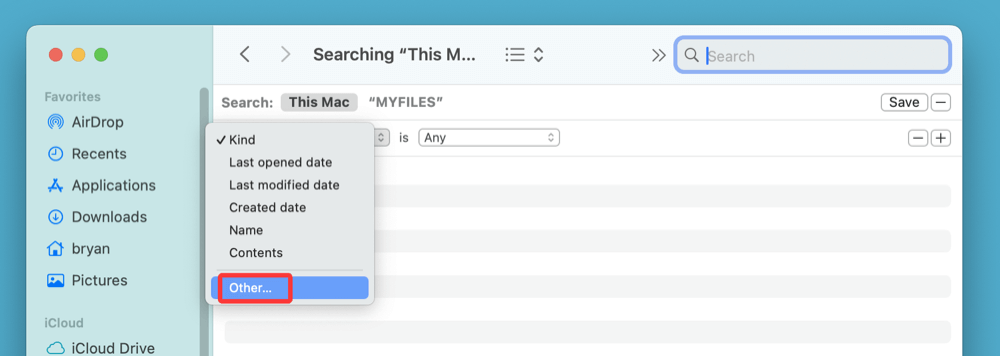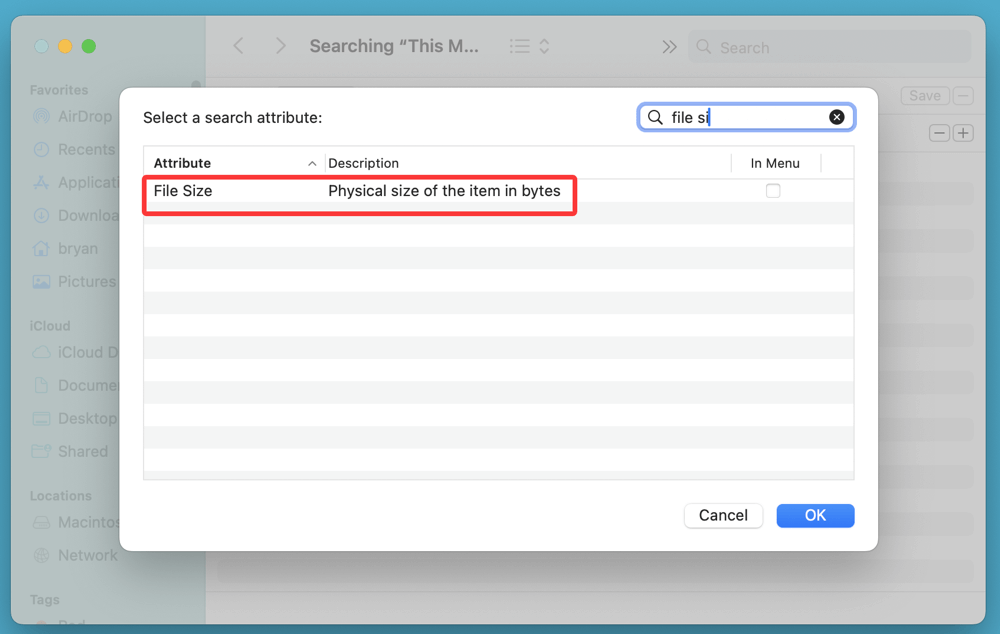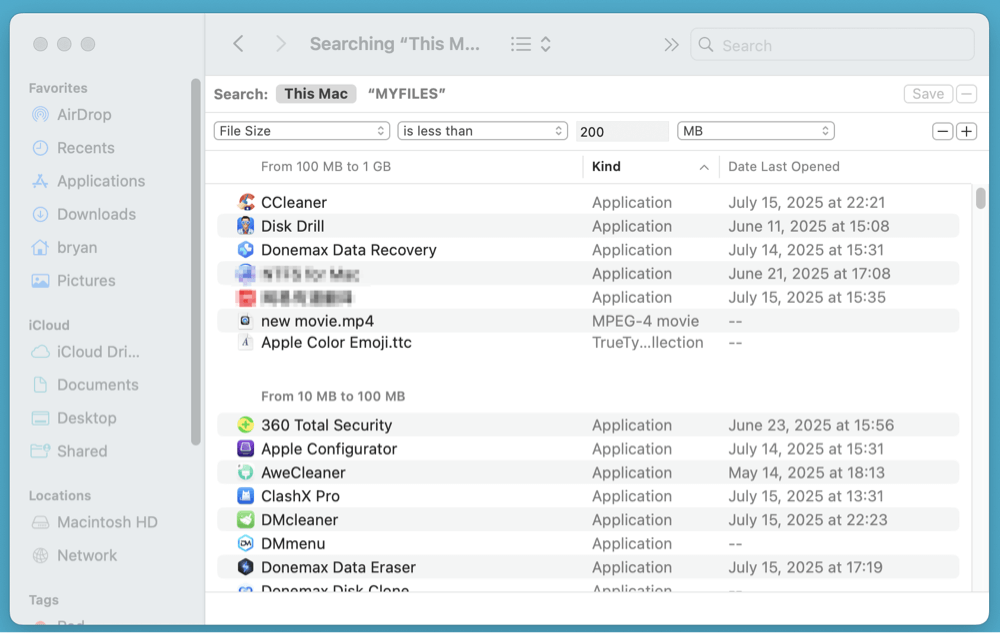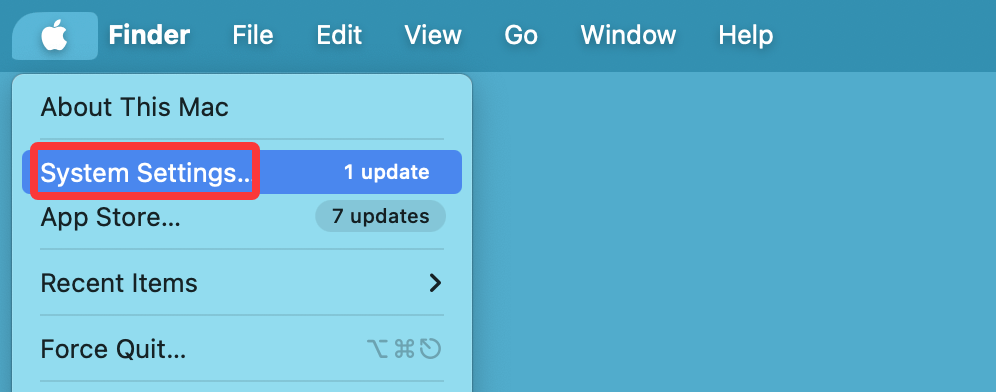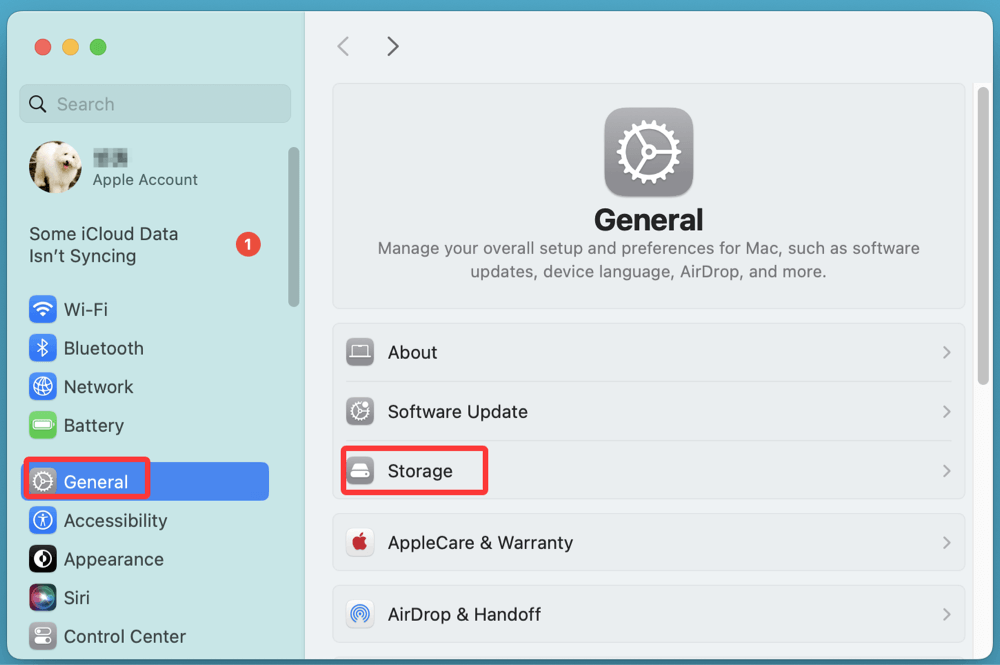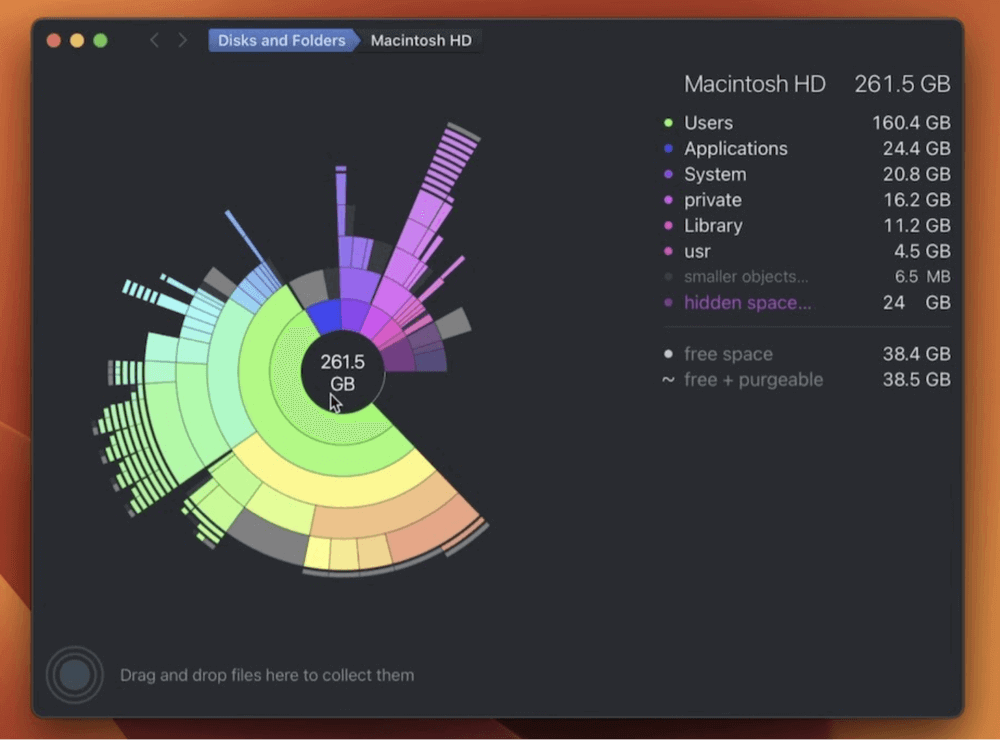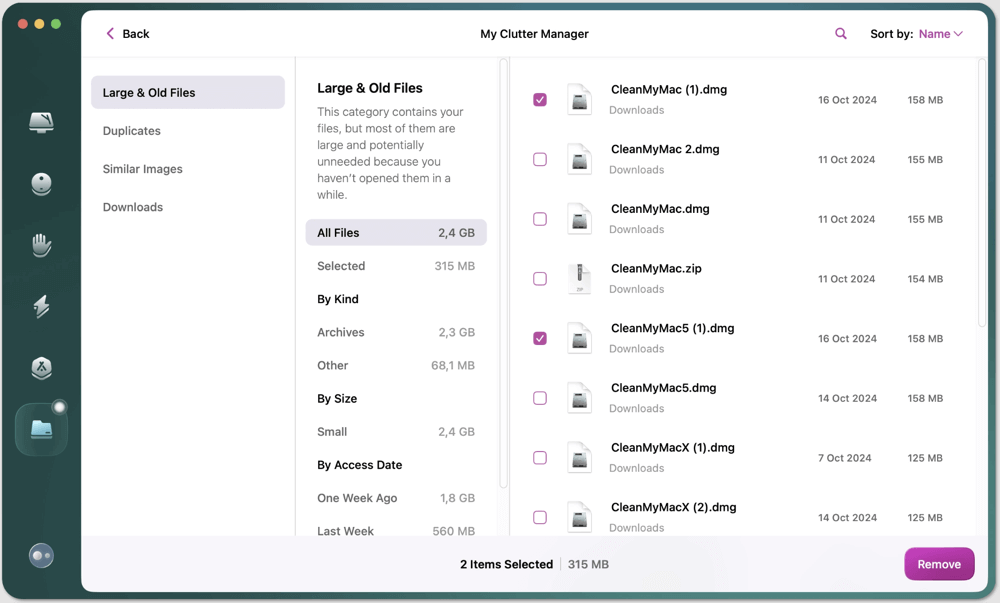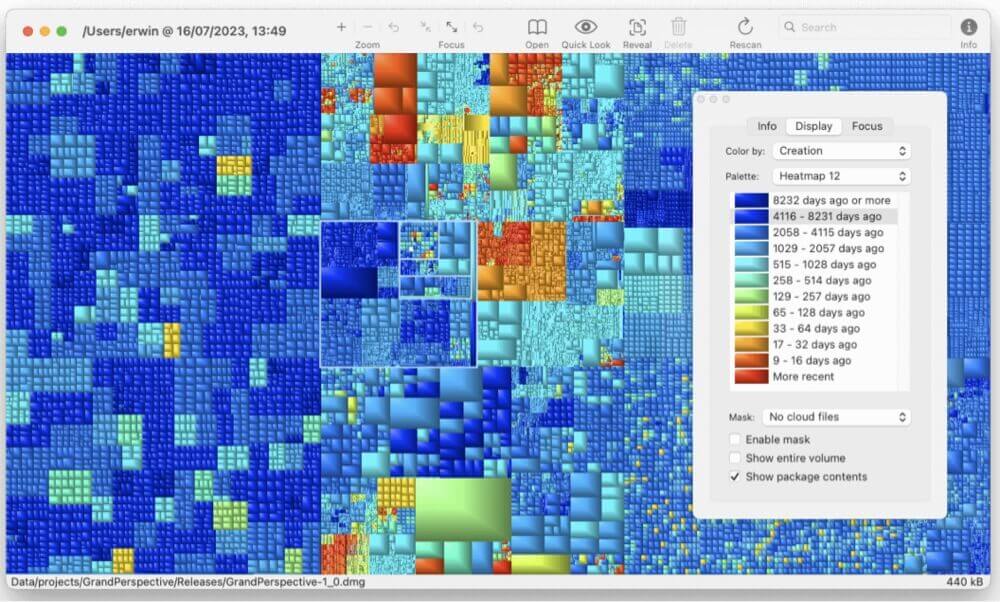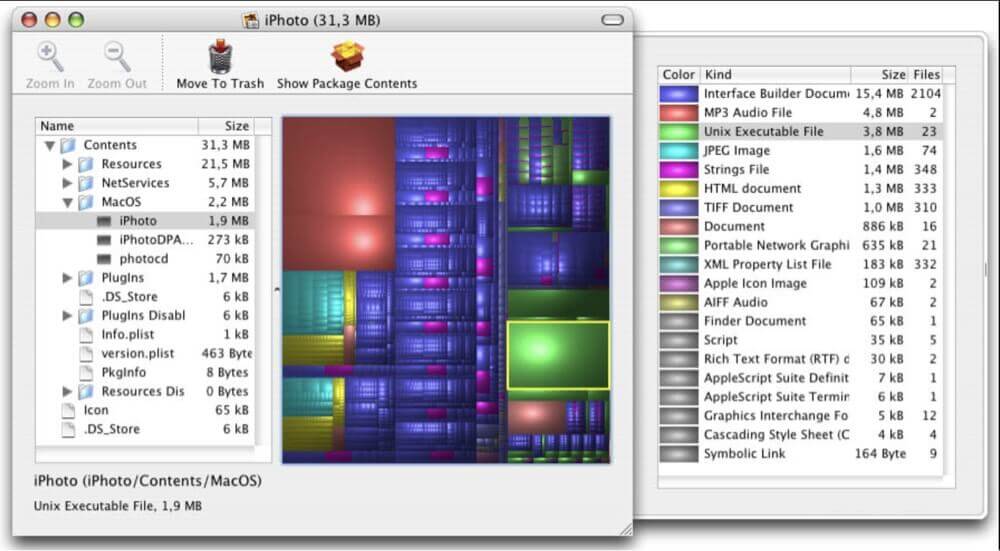Before we start: To free up disk space on Mac, you can securely delete useless large files on your Mac. DMcleaner for Mac, a reliable Mac cleaning tool, can quickly find old and large files on your Mac. You can preview all of them, then delete useless ones by only 1 click.
PAGE CONTENT:
If your Mac is running low on storage or performing sluggishly, it might be time to identify and remove large files that are hogging your disk space. Whether it's high-resolution videos, old disk images, or forgotten app caches, these large files can quietly pile up and eat into your available storage.
Thankfully, macOS offers several built-in methods to track down these space-hogging files. You can also leverage powerful third-party apps for a more detailed analysis. This comprehensive guide walks you through the best ways to find large files on Mac using Finder, Terminal, and more - so you can reclaim your precious disk space without breaking a sweat.
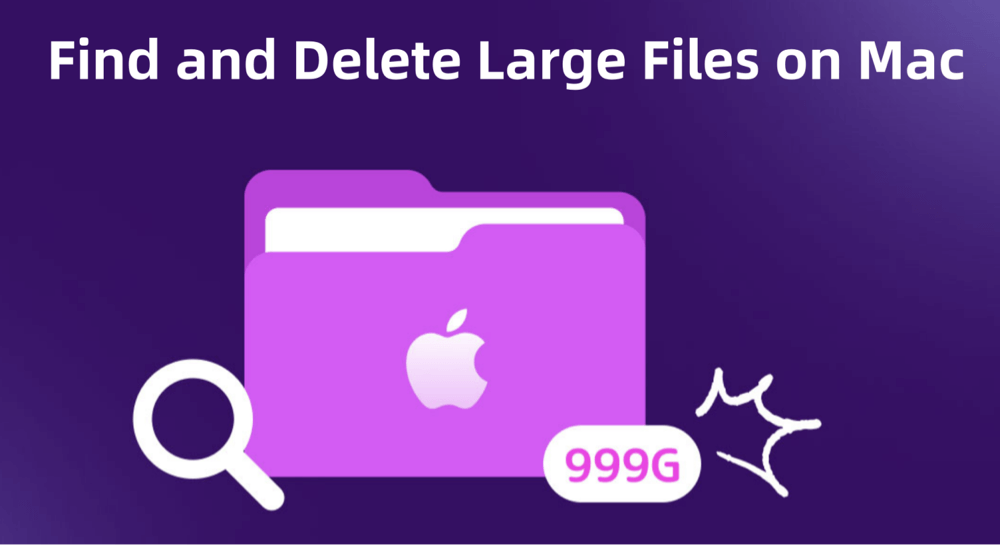
Why Finding Large Files on Mac Matters?
Over time, Macs - especially those with smaller SSDs - can quickly accumulate unnecessary data. High-resolution media files, app caches, software updates, and even forgotten backups can quietly take up gigabytes of space. The symptoms? Slower performance, system errors, and an inability to update macOS or apps due to lack of free space.
By learning how to locate and remove large files, you:
- Regain free space instantly
- Improve system performance
- Avoid costly cloud or external storage upgrades
Let's explore the easiest and most efficient methods to find these files.
Use Built-in Tools to Locate Large Files on Mac
macOS comes equipped with some helpful tools that can make finding large files straightforward and efficient. Here's how to use them.
Method 1. Find Large Files Using Finder's Smart Search
The Finder's advanced search filters let you manually find large files on your Mac.
Steps:
- Open Finder.
- Press Command + F to initiate a new search.
- In the search bar, click the first dropdown and choose "Other".
![find large files on Mac]()
![find large files on Mac]()
- Type and select "File Size", then choose "is greater than".
![find large files on Mac]()
- Enter a size value (e.g., 200 MB, 1 GB, etc.).
- Sort the results by size to find the biggest files.
![find large files on Mac]()
Pros
- No external apps required
- Customizable filters
Cons
- Can't scan system files or hidden folders
- Slower for large volumes of data
Method 2. Use macOS Storage Management Tool
Apple provides a built-in storage management utility with macOS that offers an overview of what's taking up space.
Steps:
- Click the Apple Menu > System Settings.
![find large files on Mac]()
- Click General > Storage.
![find large files on Mac]()
Then you can see what is taking up the disk space of your Mac.
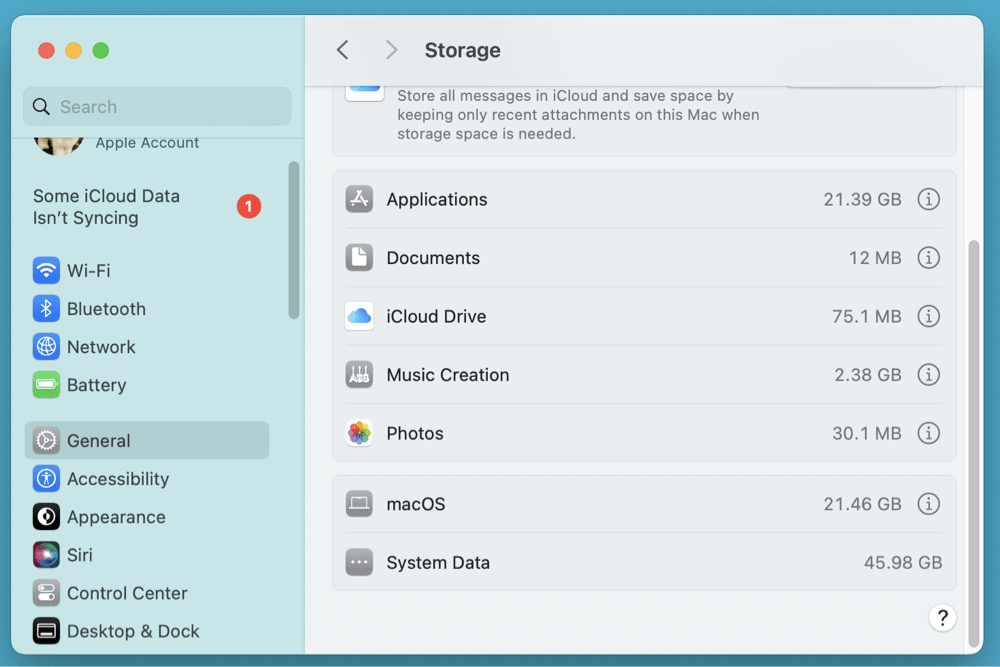
Click i behind every catalogue to check the details. You can find and delete useless large files.
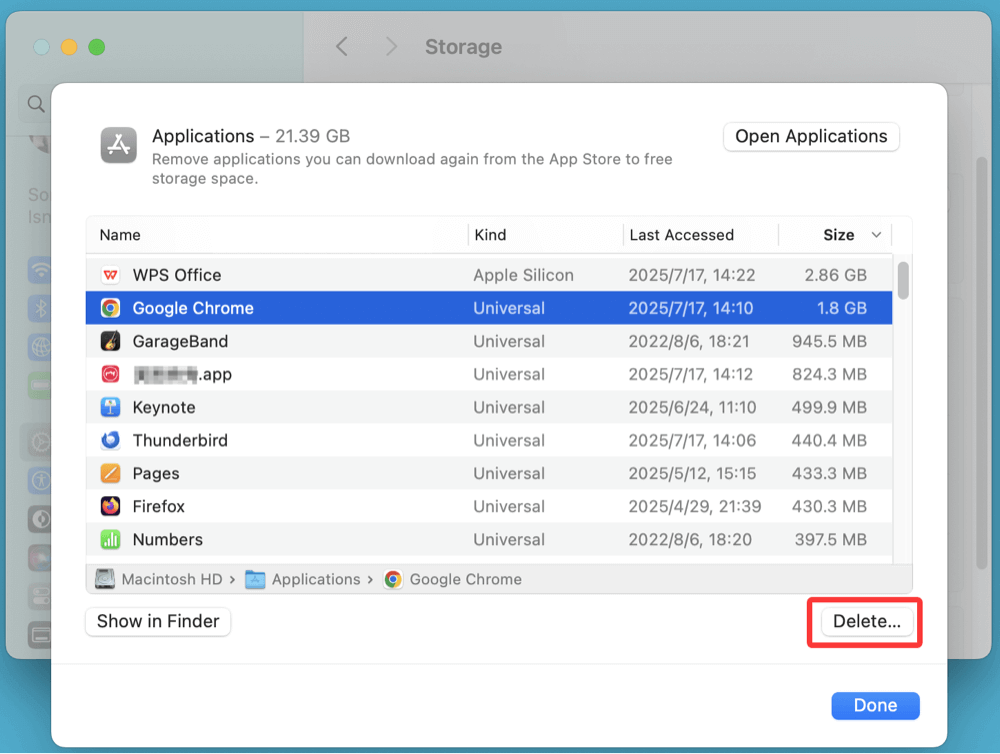
Pros
- Simple and safe for casual users
- Easy to use without technical knowledge
Cons
- Doesn't include all system files
- Limited filtering options
Method 3. Use Terminal to Find Large Files
For more advanced users, macOS's Terminal offers precise and flexible control to locate large files, including those hidden from Finder.
1. Find Files Larger Than X MB
Open Terminal from Utilities via Applications and run:
sudo find / -type f -size +500M 2>/dev/null
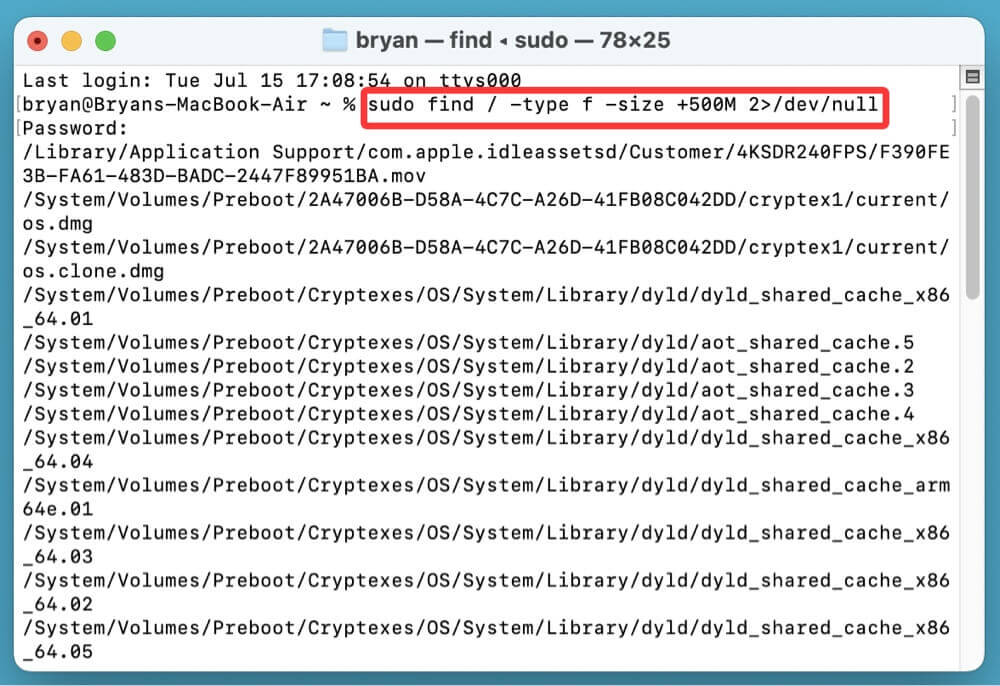
- -type f: Only files, not directories
- -size +500M: Files larger than 500 megabytes
- 2>/dev/null: Suppresses permission errors
👉 Important: Use sudo with care as it allows full system access.
Pros
- Extremely thorough
- Finds hidden or system files
Cons
- Risk of deleting critical files
- Slower and requires technical familiarity
2. List Top Largest Files in Any Directory
To display the top 20 largest files:
sudo du -ah / | sort -rh | head -n 20
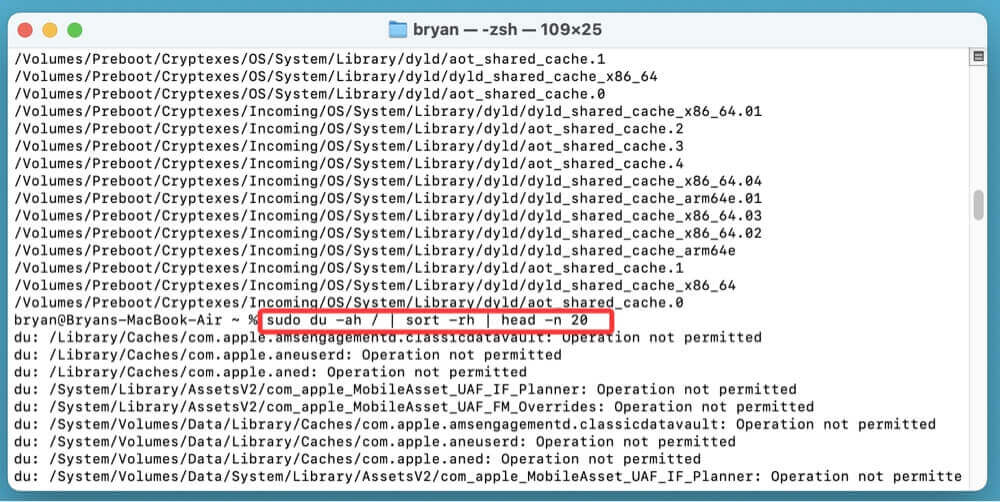
- du -ah /: Lists size of all files in root
- sort -rh: Sorts by size, descending
- head -n 20: Shows top 20 largest entries
💡 Tip: Replace / with another path like ~/Downloads to limit the search to specific folders.
Use Third-Party Apps to Find Large Files on Mac
If you prefer a visual approach or want deeper control over your files, third-party apps are a great option.
1. DMcleaner for Mac - Quick, Safe and Smart
DMcleaner for Mac is a comprehensive Mac cleanup & disk management tool. It offers large file cleaner tool to help find large & old files on your Mac. It also can help find duplicate files on Mac, find and delete junk data on Mac, etc.
Follow the steps below to find and delete large files on your Mac:
Step 1. Download and install DMcleaner for Mac, run it from Launchpad.
Step 2. Open DMcleaner for Mac, choose Large File Cleaner. Then drag and drop the target folder/volume to analyze.
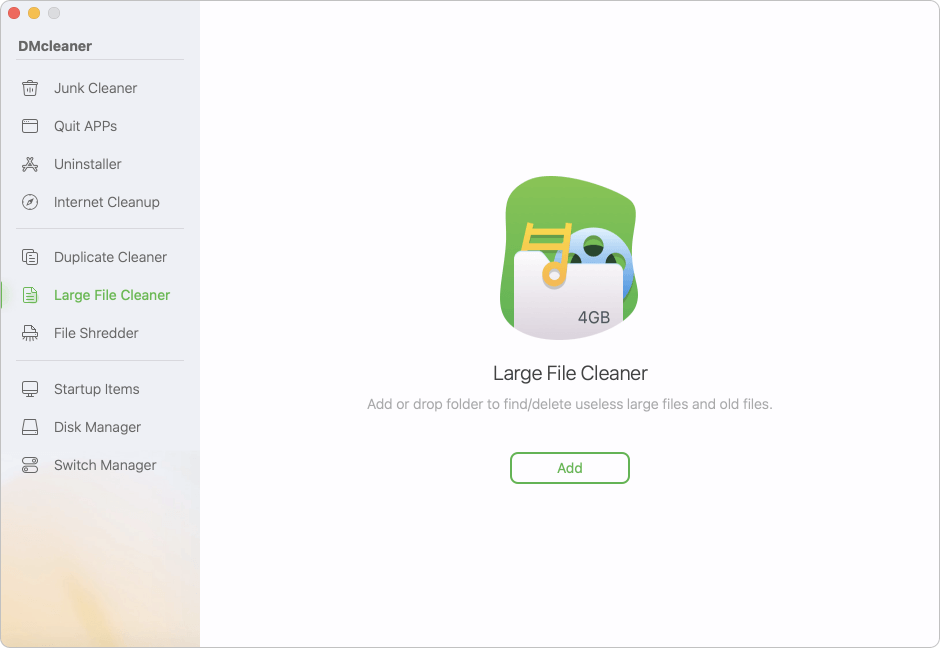
It will quickly list all files inside the folder/volume by Size.
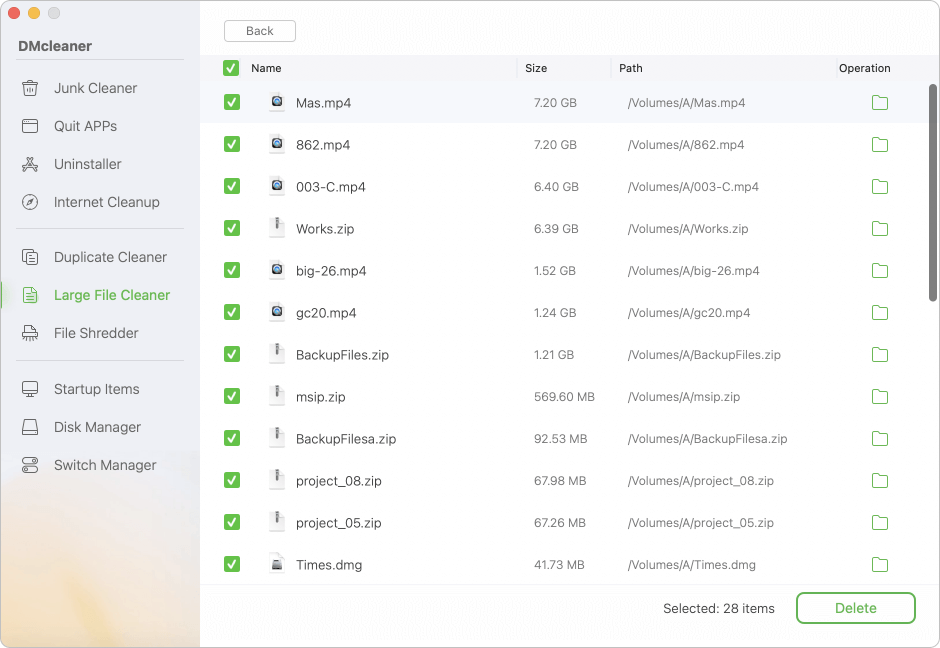
You can preview these files. Then select the ones you want to delete, click on Delete button.
DMcleaner for Mac also can help:
- Find and delete duplicate files on Mac.
- Uninstall unwanted apps and delete all leftovers.
- Clean up all junk data on Mac.
- Remove internet browsers' junk data on Mac.
2. DaisyDisk - Visual, Fast, and Intuitive
DaisyDisk is one of the most popular disk space analyzers for macOS, widely praised for its elegant interface and speed.
Key Features:
- Interactive sunburst visual map for quick file size analysis
- Fast scanning engine that works even on large drives
- Drag-and-drop deletion for selected files
- Supports both internal and external drives
How to Use DaisyDisk:
- Install from daisydiskapp.com or Mac App Store.
- Launch the app and select the disk you want to scan.
- Click "Scan" and wait for the circular graph to populate.
![find large files on Mac]()
- Hover over the segments to see folder/file details.
- Drag unwanted files to the collector and click Delete.
Best For:
- Visual thinkers
- Creatives with lots of multimedia files
- Anyone managing multiple disks
Pros
- Very easy to use
- Professional-looking interface
- Efficient for regular cleanups
Cons
- Paid app (one-time purchase around $10)
- Doesn't access restricted system folders due to macOS limitations
3. CleanMyMac X – All-in-One Optimization and Cleanup Suite
CleanMyMac X is more than just a large file finder - it's a complete Mac maintenance toolkit that includes system cleanup, malware protection, and speed optimization tools.
Key Features:
- Smart scan for system junk, caches, and large/old files
- Large & Old Files module shows files by size and last opened date
- Uninstaller, updater, and malware remover
- Intuitive interface with real-time monitoring
How to Use CleanMyMac X to Find Large Files:
- Download and install from macpaw.com.
- Launch the app and go to Large & Old Files.
- Select the drive and start the scan.
- Review and filter files by size, type, or last access date.
![find large files on Mac]()
- Mark files for deletion and click Remove.
Best For:
- Users looking for an all-in-one Mac maintenance tool
- Frequent system optimizers and power users
Pros
- Extremely user-friendly
- Offers deeper cleanup beyond large files
- Regular updates and support
Cons
- Subscription-based pricing (with trial version)
- Some features may feel overwhelming for minimal users
4. GrandPerspective – Free and Lightweight
GrandPerspective is a no-frills, open-source macOS application that provides a treemap visualization of your file system.
Key Features:
- Treemap-style graphical representation of disk usage
- Lightweight and free
- Configurable display settings
How to Use GrandPerspective:
- Download from grandperspectiv.sourceforge.net.
- Launch the app and choose a folder or drive to scan.
- The app displays boxes of different sizes/colors based on file size.
![find large files on Mac]()
- Click on a box to preview the file, and delete if necessary.
Best For:
- Advanced users and minimalists
- People looking for a free, functional solution
Pros
- Open source and free
- Fast scanning
- Visual and accurate file representation
Cons
- Interface looks dated
- Less intuitive compared to premium apps
- Limited support and updates
5. Disk Inventory X - Another Free Tree Map Analyzer
Disk Inventory X is a similar alternative to GrandPerspective, offering a detailed tree map layout of your disk's contents.
Key Features:
- Displays directory sizes graphically
- Shows file types and sizes with color-coded blocks
- Lightweight and simple to use
How to Use Disk Inventory X:
- Download from diskinventoryx.com.
- Select the drive to scan.
- View results in a combined list and treemap format.
- Use the color legend to locate large files by type.
![find large files on Mac]()
Best For:
- Users who prefer list + visual layout
- Free alternative to DaisyDisk
Pros
- Cost-free
- Color-coded map with legend
- Easy to identify large media files
Cons
- Outdated interface
- Occasional crashes on newer macOS versions
Tips for Managing Storage After Finding Large Files
Finding large files is just one part of the storage-cleanup process. Here's how to manage them responsibly:
1. Delete or Move Large Files
Before deleting, ask:
- Do I still need this file?
- Can it be backed up or moved to external/cloud storage?
Options:
- Move to external hard drive or USB flash drive
- Upload to iCloud, Google Drive, or Dropbox
2. Archive Infrequently Used Files
If you don't want to delete files permanently but rarely access them, consider archiving.
Use macOS's built-in Compress feature: Right-click file/folder > Compress
3. Empty Trash
Deleted files remain in the Trash until it's emptied.
Right-click the Trash icon > Empty Trash
4. Back Up Important Files
Use Time Machine or third-party solutions to ensure important data is always recoverable.
Common Locations Where Large Files Accumulate
Knowing where to look helps target your efforts.
1. Downloads Folder
Often overlooked, this folder stores:
- Disk images
- Large media files
- Software installers
Clean it regularly.
2. ~/Library/Application Support
This folder can hold:
- Game data
- Video project files
- App caches
Be cautious when deleting - some files are essential.
3. Photos, Music, and iMovie Libraries
Media libraries grow over time:
- iMovie renders and events
- Final Cut Pro backups
- iTunes/Music downloads
Use library management tools to trim them.
4. Old iOS Backups
Stored in:
~/Library/Application Support/MobileSync/Backup
Delete them via Finder or iTunes if they’re no longer needed.
5. Disk Images and Virtual Machines
Check for .dmg, .iso, .vdi, and .vmwarevm files that are no longer required.
Automate Large File Management
To save time and keep your Mac optimized, consider setting up automation.
1. Smart Folders
Create dynamic folders that always show large files:
- Finder > File > New Smart Folder
- Add "File Size" filter
2. Automator Scripts
Use Automator to create workflows that:
- Scan directories for large files
- Move them to specific folders
3. Scheduled Cleanups
Apps like CleanMyMac X allow for:
- Regular reminders
- Automatic cache cleaning
- Smart analysis reports
Conclusion
Freeing up space on your Mac doesn't have to be complicated. Whether you're using Finder, Terminal, or an app like DMcleaner for Mac, finding and managing large files is a straightforward way to boost performance and regain control of your storage.
Here's a quick recap:
- Finder and Storage Management work great for beginners.
- Terminal offers deep control for advanced users.
- Apps like DMcleaner quickly find and delete large or old files.
Make a habit of reviewing your Mac's storage every few months, and you'll avoid storage woes before they begin. After all, a well-maintained Mac is a happy (and speedy) Mac.


DMcleaner for Mac
Donemax DMcleaner for Mac is an award-winning Mac cleanup & maintenance application. It offers 10+ tools to help Mac users clean up junk data on Mac, uninstall unwanted apps & delete leftovers, shred files, delete duplicate files, free up disk space, speed up slow Mac, etc. It is also a smart switch manager for Mac, a powerful disk manager for Mac.
Related Articles
- Jul 04, 2025Create a Bootable USB Installer for macOS Mojave
- Jun 26, 2025Where Are Voice Memos Stored on Mac?
- Jun 16, 2025How to Compress Files on Mac – Guide 2025
- Aug 12, 2025How to Turn Off Mac Notifications on Mac: Complete Guide for All macOS Versions
- Jul 27, 2025Fix Wrong Date and Time on Mac: Complete Troubleshooting Guide
- Feb 06, 2025[7 Fixes] Fix Volume Hash Mismatch Error on Mac Without Losing Data

Charles
Charles, who lives in Sydney, Australia, is an editor & writer of Donemax Team. He is good at writing articles related with Apple Mac computers, Windows operating systems, data recovery, data erasure, disk clone and data backup, etc. He loves reading and playing tennis in his spare time and is interested in testing new digital devices such as mobile phones, Macs, HDDs, SSDs, digital cameras, etc.

Gerhard Chou
In order to effectively solve the problems for our customers, every article and troubleshooting solution published on our website has been strictly tested and practiced. Our editors love researching and using computers and testing software, and are willing to help computer users with their problems

